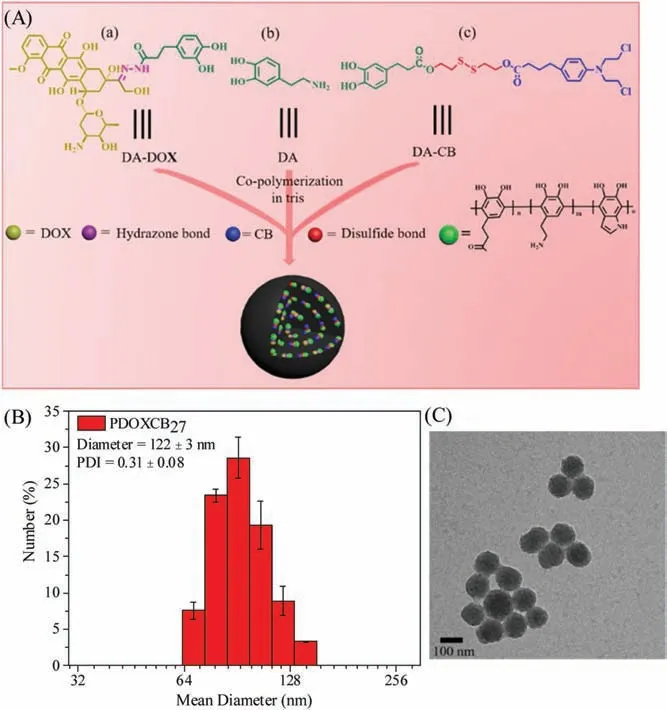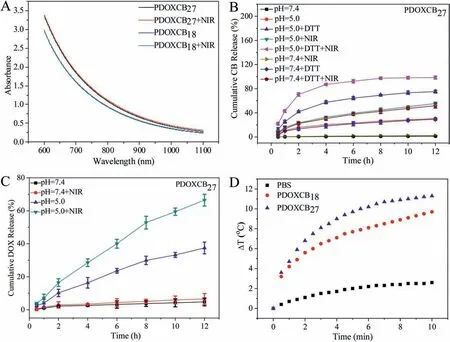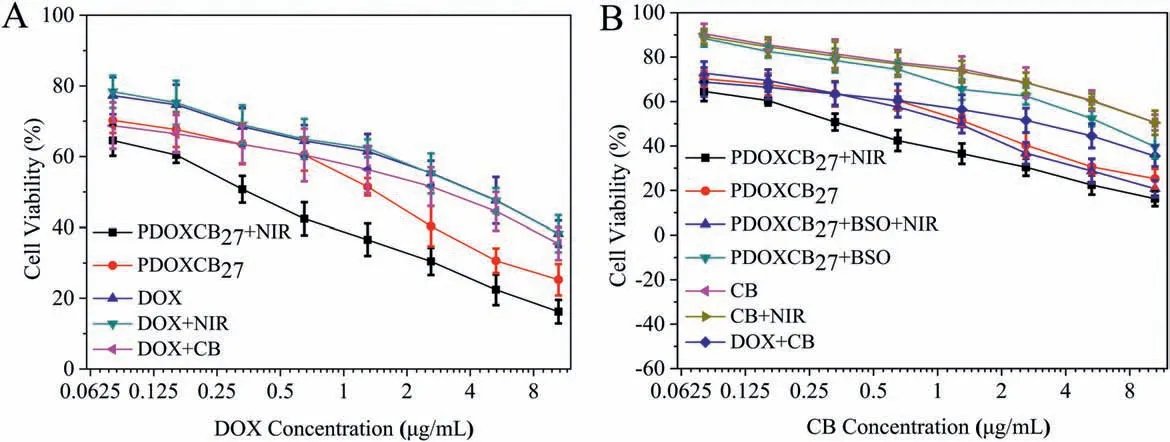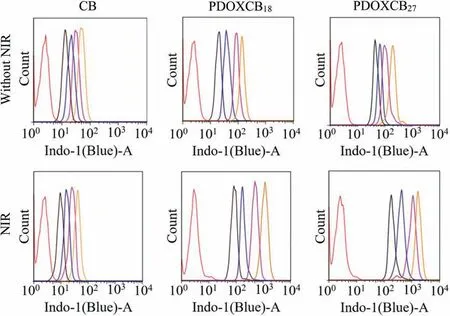Stimuli-responsive dual drugs-conjugated polydopamine nanoparticles for the combination photothermal-cocktail chemotherapy
2021-04-02LeiZhouChangDuRongZhangChangmingDong
Lei Zhou,Chang Du,Rong Zhang*,Changming Dong*
a School of Chemistry and Chemical Engineering, Shanghai Key Laboratory of Electrical Insulation and Thermal Aging, Shanghai Jiao Tong University, Shanghai 200240, China
b Joint Research Center for Precision Medicine, Department of Obstetrics and Gynecology, Shanghai Jiao Tong University Affiliated Sixth People’s Hospital South Campus, Shanghai Fengxian Central Hospital, Shanghai 201499, China
ABSTRACT We developed one-pot aqueous copolymerization of two dopamine prodrugs to prepare dual drugsconjugated polydopamine nanoparticles (PDOXCBs), which integrated near infrared (NIR)-mediated photothermal effect with cocktail chemotherapy into one copolymer nanoparticle.Upon a mild NIR irradiation (808 nm,1 W/cm2,10 min), PDOXCBs gradually heated aqueous solution over 12.8-13.9°C,which accordingly enhanced in vitro dual doxorubicin (DOX) and chlorambucil (CB) drug-release with assistance of the other stimuli of pH 5.0 and 10 mmol/L D,L-dithiothreitol (DTT).The combination photothermal-cocktail chemotherapy(PTT-CCT)treatment based on PDOXCB27 plus NIR irradiation gave a highly lowered half maximal inhibitory concentration(IC50)of 2.23 μg/mL and a combination index of 0.36, displaying a superior synergistic effect between PTT and CCT in vitro.
Keywords:Near infrared Polymer drug conjugate Cocktail chemotherapy Photothermal therapy Combination therapy
Recently, the noninvasive PTT mediated by NIR 700-1000 nm and its combination treatments with chemotherapy made great achievements for completely eradicating tumors, overcoming multidrug resistance, enhancing antitumor immunity, and inducing synergistic antitumor efficacy [1-3].However, the polymeric drug conjugate (i.e., polyprodrug) based PTT is rarely studied because of their complicate synthesis and non-conjugated backbones without NIR stimulus [4,5].On the other hand, the hightemperature PTT treatment (e.g., >50°C) killed cancer cells via a necrosis pathway rather than an apoptosis one, thus caused detrimental proinflammatory response and tumor metastasis,along with heavy tissue damage[5-8].Therefore,developing mild PTT-based combination treatment would provide a practicable regime for the cancer therapy transition[7,8].In our previous work[4,5],we have established an efficient strategy for the preparation of polydopamine(PDA)based drug conjugates for the cancer PTTchemotherapy treatments.Herein, we report anovel kind of PDOXCBs, which integrated the combination of PTT with CCT(i.e.,simultaneous release of dual drug pair or multiple ones)into one multifunctional copolymer nanoparticle and exhibited synergistic efficacy for killing MCF-7 cells.
The oxidative precipitation polymerization of dopamine provides a powerful strategy for the direct preparation of PDA nanoparticles in aqueous solution, which have wide applications for cancer PTT and related theranostics [2-6].Therefore, we synthesized two prodrugs of the dopamine-doxorubicin(DA-DOX)with an acid-labile hydrazone bond and the other dopaminechlorambucil (DA--CB) with areduction-responsive disulfide according to our previous work[4,5],and obtained the copolymer nanoparticles of PDOXCBs by the copolymerization of DA-DOX,DA--CB and DA in trometamol solution at 30°C for 24 h(Fig.1A).To balance PTT and CCT within one nanoparticle having a suitable size of sub-200 nm,wetosome extent lowered the pure dopamine(DA) content while increased both prodrugs to obtain PDOXCBs(Table 1).The chemical structures, sizes and morphology of PDOXCBSwere fully characterized by Fourier transform infrared(FT-IR) spectroscopy, X-ray photoelectron spectroscopy (XPS),dynamic light scattering(DLS),and transmission electron microscopy(TEM).FT-IR spectra gave typical vibration peaks at 1703 cm-1for the hydrazone bond,1732 cm-1and 804 cm-1for CB, besides indole at 1625-1640 cm-1, verifying PDOXCBs were composed of DA--DOX,DA--CB and DA(Fig.S1 in Supporting information).This was further evidenced by XPS, which showed the binding energy peaks of C=N--N at 402 eV(C=N),--S--S--at 163.7 eV,--COO--at 533.5 eV and C-Cl at 201.7 eV(Fig.S2 in Supporting information).Both DLS and TEM indicate that PDOXCBs have average hydrodynamic diameters ranging from 120 nm to 130 nm,nearly spherical morphology,along with negative zeta potential of about-30 mV in aqueous solution (Figs.1B and C, Fig.S3 in Supporting information).Collectively,the above analyses demonstrate PDOXCBScan be easily prepared by aqueous precipitation copolymerization of both DA-DOX and DA--CB with DA under mild conditions.

Fig.1.(A) One-pot aqueous precipitation copolymerization for the preparation of dual drugs-conjugated PDOXCBs nanoparticles.(B) DLS and (C)TEM data for PDOXCB27.
As shown in Fig.2A, PDOXCBs gave a broad NIR absorbance similar to pure PDA counterpart and kept stable upon a mild NIR irradiation (808 nm, 1 W/cm2, 10 min).At a concentration of 280-300 μg/mL, they gradually heated the aqueous solution over 12.8-13.9°C compared to PBS with a small elevation of 2.6°C(Fig.2B), exhibiting a mild photothermal effect.Meanwhile, the repeated heating-cooling curves evidenced that they had a high photostability and a good photothermal conversion efficiency of about 33% (as calculated from Fig.S4 in Supporting information),which was lower than that of pure PDA (44% at same conditions)[4,5].Note that PDOXCBSindividually presented the nanoparticles concentration or the laser power density dependent temperature increase profiles(Fig.S5 in Supporting information),which means that they can also be applied for high temperature PTT(i.e.,>50°C at the target site).In addition,PDOXCBSwere dispersed well in PBS(10 mmol/L, pH 7.4) or in different concentrations of fetal bovine serum (FBS, 1-10 wt%) at 37°C.The time-dependent hydrodynamic diametersof PDOXCBSwere monitored by DLS,which hardly changed in PBS for two months at 4°C.Their diameters kept stable in fetal bovine serum(FBS)within 8 h at 37°C and then increased to < 200 nm for 24 h (Fig.S6 in Supporting information),suggesting a high stability of PDOXCBs in physiological conditions.
Considering the acid-labile nature of hydrazone and the reduction-responsivity of disulfide, the external NIR stimulus with the other two internal triggers (e.g., pH 5.0 to mimic the endolysosomal acidity and 10 mmol/L DTT to mimic the intracellular reduction) induced a synergistic acceleration action on the drug release of PDOXCBs in vitro.Taking PDOXCB27as an example(Figs.2C and D),the triple triggers of NIR+10 mmol/L DTT+pH 5.0 obviously induced the fastest drug-release profile with 70.3 wt%CB and 16.5 wt% DOX release for 2 h than dual or single or without triggers.At pH 5.0, the DOX and CB release were approximately 10.2 wt%and 15.9 wt%for 2 h compared to those(about 2.2 wt%and 0.5 wt%) at pH 7.4.Upon 10 mmol/L DTT+pH 7.4 or 10 mmol/L DTT+pH 5.0, the CB release attained up to 13.4 wt% and 41.7 wt%for 2 h, respectively.Similar triple stimuli-triggered drug release behavior was found for PDOXCB18(Fig.S7 in Supporting information).Collectively, the dual drugs-conjugated PDOXCBs present a mild NIR-mediated photothermal conversion property and triple stimuli-triggered(i.e.,pH 5.0,10 mmol/L DTTand NIR)drug-release(i.e., simultaneous DOX and CB release) profiles, which would produce a synergistic effect between PTT and CCT [6,9,10].
To evaluate in vitro antitumor efficacy of the polyprodrug release induced CCT (i.e., dual DOX and CB release induced chemotherapy), the NIR-mediated PTT, and the combination PTT-CCT of PDOXCBs, we investigated their cytotoxicities under different stimuli by a methyl tetrazolium (MTT) assay.The MCF-7 and L929 cells were incubated with PDA or with NIR irradiation(808 nm,1 W/cm2,10 min),and the cell viabilities kept above 95%(Fig.S8 in Supporting information).That is to say, both this mild NIR irradiation and the PDA itself induced negligible toxicity to these healthy and carcinoma cell lines.Both PDOXCB18and PDOXCB27showed concentration-dependent cytotoxicity against cancer cells(Fig.3).Upon the NIR irradiation or without irradiation or with addition of 0.1 mmol/L BSO (an inhibitor to prohibit the cytosolic synthesis of reductive GSH),the MCF-7 cells were treated with PDOXCBSor DOX or CB or DOX+CB for 48 h, respectively[5,11].The IC50values of PDOXCB27greatly increased from 2.33 μg/mL to 10.93 μg/mL when added with 0.1 mmol/L BSO,and similar tendency was obtained for PDOXCB18.These results suggested the reduction-responsive release of CB was inhibited by BSO,thus resulting in the decreased cytotoxicity.Based on the DOX and CB concentration, both PDOXCB18and PDOXCB27individually gave an IC50of 3.01 μg/mL and 2.23 μg/mL for single CCT.As for the combination PTT-CCT, PDOXCB18gave an IC50of 4.70 μg/mL for the combination PTT and that of 1.03 μg/mL for the combination CCT; however, PDOXCB27showed a lowered IC50of 2.23 μg/mL,which consisted of those of 1.99 μg/mL and 0.74 μg/mL for thecombination PTT and the combination CCT,respectively(Fig.3 and Table 1).As PDOXCBshave similar backbone to pure PDA[4,5,12,13], the single PTT of PDOXCBswas determined on the basis of PDA under the same NIR irradiation,which was calculated to be 69.34 μg/mL (Fig.S9 in Supporting information).The combination effect between different therapies is generally assessed by the combination index (CI) [14,15].CI <1 suggests a synergistic effect otherwise CI ≥1 denotes an antagonistic or additive action;the smaller the CI is,the better different therapies act synergistically.Both PDOXCB18and PDOXCB27had a lower CI of 0.41 and 0.36, respectively (Table 1), demonstrating that the combination PTT-CCT possessed superior and synergistic antitumor effect in vitro.

Table 1 Characterization of the PDOXCBS nanoparticles and their cytotoxicities when incubated with MCF-7 under different conditions.

Fig.2.(A)The Vis-NIR spectra ofthe PDOXCBs solution with or without NIR irradiation(808 nm,1 W/cm2,10 min).(B)The temperature-elevation magnitude of the PDOXCBs solution (PDOXCB18: 280 μg/mL; PDOXCB27: 300 μg/mL) dependent on the irradiation time upon the NIR irradiation.The stimuli-sensitive dual drug-releases profiles(C, DOX; D, CB) of PDOXCB27 in PBS at 37°C (n=6).

Fig.3.The cytotoxicities of PDOXCB27 dependent on DOX(A)or CB(B)when incubated with MCF-7 with/without NIR irradiation or addition of BSO in contrast to free DOX,CB and free DOX+CB (n=6).

Fig.4.Flow cytometry histograms of the MCF-7 cells incubated with PDOXCBs(10 μg/mL CB equiv.)or free CB(10 μg/mL)with/without the NIR irradiation at different times(red, control; black, 0.5 h; blue,1 h; pink, 2 h; orange, 4 h).
Efficient delivery of therapeutic agents into the cytoplasm or nucleus is crucial for the cancer treatment [16].By taking advantage of intrinsic red fluorescence of DOX and blue fluorescence of CB,the cellular uptake of PDOXCBSand intracellular DOX or CB release with/without the mild NIR irradiation were monitored by confocal laserscanning microscopy (CLSM, Fig.S10 in Supporting information).Three types of fluorescence were detected, which were the green color emitted from AO (stained forcell nucleus), the red color from DOX, and the blue color from CB.The MCF-7 cells treated with PDOXCBs plusthe NIR irradiation showed strongest yellow color (the merged color of the blue one from CB,the red one from DOX,and the AO-stained green nuclei)at 4 h than those without the NIR irradiation or with free DOX+CB,which evidenced that the NIR irradiation could enhance the cellular uptake of PDOXCBSand the related dual drug-releases inside the cells.To quantify the cellular uptake, flow cytometric analysis was then performed by using MCF-7 cells treated with PDOXCBS(10 μg/mL CB equiv.)with/without the NIR irradiation for different incubation time (Fig.4).PDOXCBSpresented a timedependent cellular internalization behavior similar to free CB.Compared with that of free CB (10 μg/mL CB), the mean fluorescence intensity of PDOXCBSincubated with the MCF-7 cells increased about 2.7~3.2-fold at 4 h (Fig.S11 in Supporting information).This result indicates that PDOXCBScould enhance the cellular uptake of CB probably via an endocytosis path rather than the diffusion of free drugs [4,5,16].Upon the mild NIR irradiation, the mean fluorescence intensity of the PDOXCBSincubated MCF-7 cells increased about 3.9-4.3-fold at 4 h compared to those without irradiation.This obviously demonstrated that the NIR-mediated photothermia effect further promoted the cellular internalization of PDOXCBSbecause the endocytosis of nanoparticles was an energy-dependent process.These flow cytometry and CLSM data were consistent with each other.In all, these findings indicate that PDOXCBSwith diameters of <150 nm might be efficiently internalized by the MCF-7 cells and capable of releasing dual CB and DOX drugs inside the cells.
In summary,the dual drugs-conjugated PDOXCBs nanoparticles were facilely prepared by utilizing one-pot aqueous precipitation copolymerization of two dopamine prodrugs under mild conditions,which integrated the intrinsic NIR-mediated photothermia of PDA backbone with the polyprodrug-induced cocktail chemotherapy (i.e., simultaneous release of DOX and CB) into one nanoparticle.PDOXCBs present a mild photothermal conversion property and triple stimuli-triggered (i.e., pH 5.0,10 mmol/L DTT and NIR) drug-release profiles.When the MCF-7 cells were incubated with PDOXCB27plus a mild NIR irradiation (808 nm,1 W/cm2, 10 min), the combination PTT-CCT treatment gave a highly lowered IC50of 2.23 μg/mL than single PTT or CCT and a combination index of 0.36,exhibiting a superior synergistic effect between PTT and CCT in vitro.Therefore, this work establishes a versatile platform for one-pot preparation of the NIR-responsive polyprodrug-based nanoparticles with potential application in the combination PTT-CCT.
Acknowledgments
The authors thank for National Natural Science Foundation of China (No.21774074), the Innovation Program of Shanghai Municipal Education Commission (No.201701070002E0061),and the Innovation Fund (No.IFPM2019A004) of Shanghai Jiao Tong University&Affiliated Sixth People’s Hospital South Campus.
Appendix A.Supplementary data
Supplementary material related to this article can be found, in the online version, at doi:https://doi.org/10.1016/j.cclet.2020.02.043.
杂志排行
Chinese Chemical Letters的其它文章
- Diverse synthesis of the C ring fragment of bryostatins via Zn/Cu-promoted conjugate addition of α-hydroxy iodide with enone
- Directly conversion the biomass-waste to Si/C composite anode materials for advanced lithium ion batteries
- Mechanism and selectivity of copper-catalyzed borocyanation of 1-aryl-1,3-butadienes: A computational study
- Recent advances in the improvement of g-C3N4 based photocatalytic materials
- In-situ electro-deposition synthesis of MnOx-NiCo2O4 monolithic catalyst with rich phase interfaces
- Aconapelsulfonines A and B, seco C20-diterpenoid alkaloids deriving via Criegee rearrangements of napelline skeleton from Aconitum carmichaelii
